Introduction
The basic elements of the effective presentation include:
- powerful message,
- appropriate and limited content,
- efficient design.
The power of visual aids is based upon the fact that individuals:
- think visually,
- remember visually,
- engage visually way more often that they do with their senses.
Making a good impression within the working team is of the utmost importance in modern society. PowerPoint presentations were primarily designed to assist in business meetings (Fig. 1) while introducing the necessary information to draw attention of the audience. The following analysis includes various strategies that lead to the effective presentation and is based upon the studies of Jeavons, Morton, and Kawasaki. Presentations are worth rethinking as they must be created with care and consideration. With that said, visual aids are the powerful element of the presentation formula since individuals think, remember, and perceive information visually.
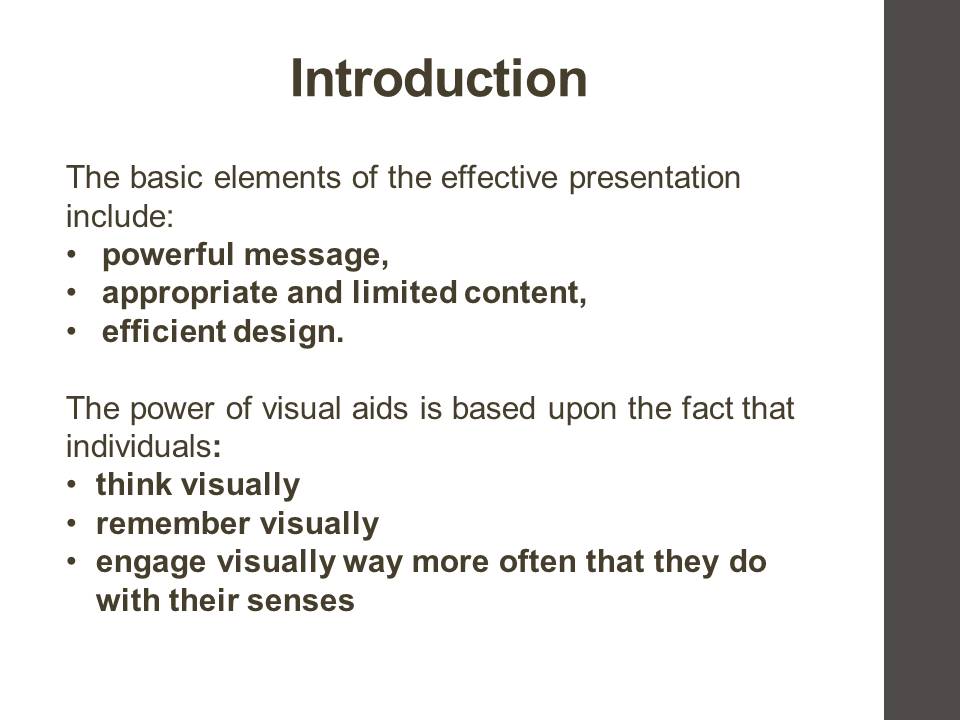
Business Meetings
Three steps that can be stated in 90-seconds or less in order to save time and avoid stress include:
- Goal of the meeting,
- Current situation,
- Agenda statement.

Within the context of a business world, the effective presentation skills might be helpful during the business meetings, whether it implies the project updates or decision-making. It is generally accepted that business meetings need a clear agenda. First, the communicator has to state the goal of the meeting; however, not his goal but the goal of everyone else in the room. The information presented has to promote achieving or accomplishing the particular goals and the main task is to define these goals.
If the person conducts a budget meeting, the ultimate goal might be to save money. In case of a project update meeting, the goal is simply to move on to the next stage of the project. The alternative goal might be to brainstorm ideas.
The second step after stating your goal is to state the current situation. This step aims at getting support from other meeting attendees. This might include current problems, challenges or obstacles the listeners face as it refers to meeting the goal. The third step requires stating the agenda excluding any detailed information on any topic. The third step is focused on stating the topic that will be covered in the presentation and might be helpful throughout the meeting as a reference point to keep the conversations on track.
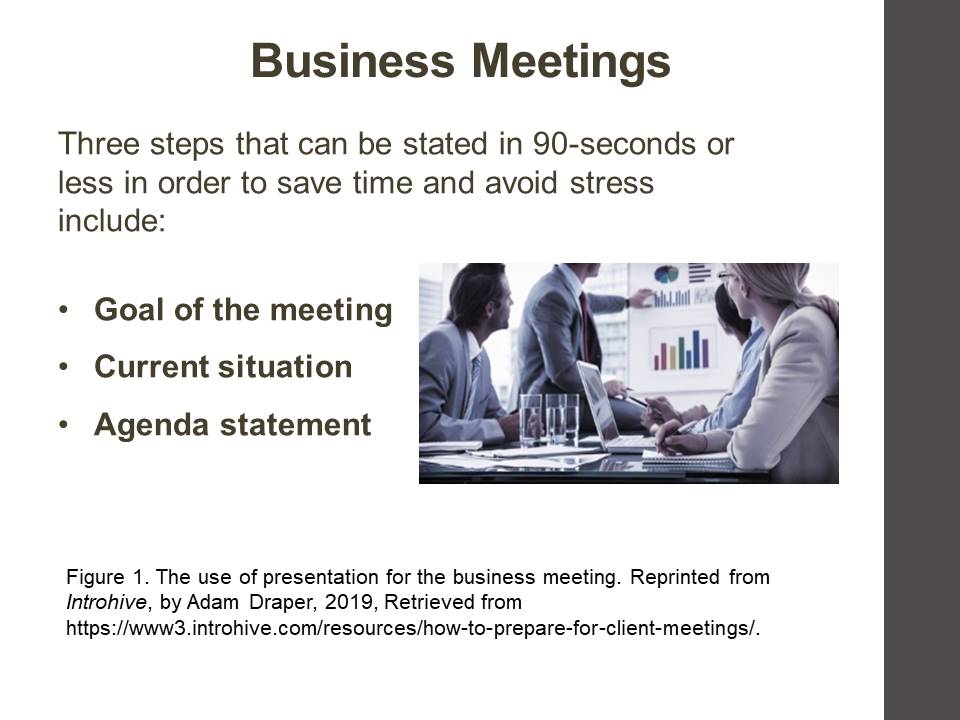
Three Techniques for Business Meetings
While taking a role of the communicator, it is essential to implement the following three techniques provided by Jeavons (2019):
- 90-Second “Wow the Crowd” Meeting Kickoff: goal – current situation – agenda.
- Command the Room: refer to your agenda – do not maintain eye contact.
- What’s Next?
The second technique pursues the control maintenance by keeping the meeting on track and successfully side stepping those who intend to derail the speaker. The first step implies referring back to the agenda in case when someone dominates the conversation. One might reference the amount of time remaining and request that the conversation be managed at another time. Jeavons (2019) suggests to avoid the eye contact with the audience, when someone is taking over the conversation to refrain the negative energy. Ultimately, the presentation time should not take the overall time of the meeting since it is important to negotiate the critical questions and next strategic steps of the company at the end of the session.
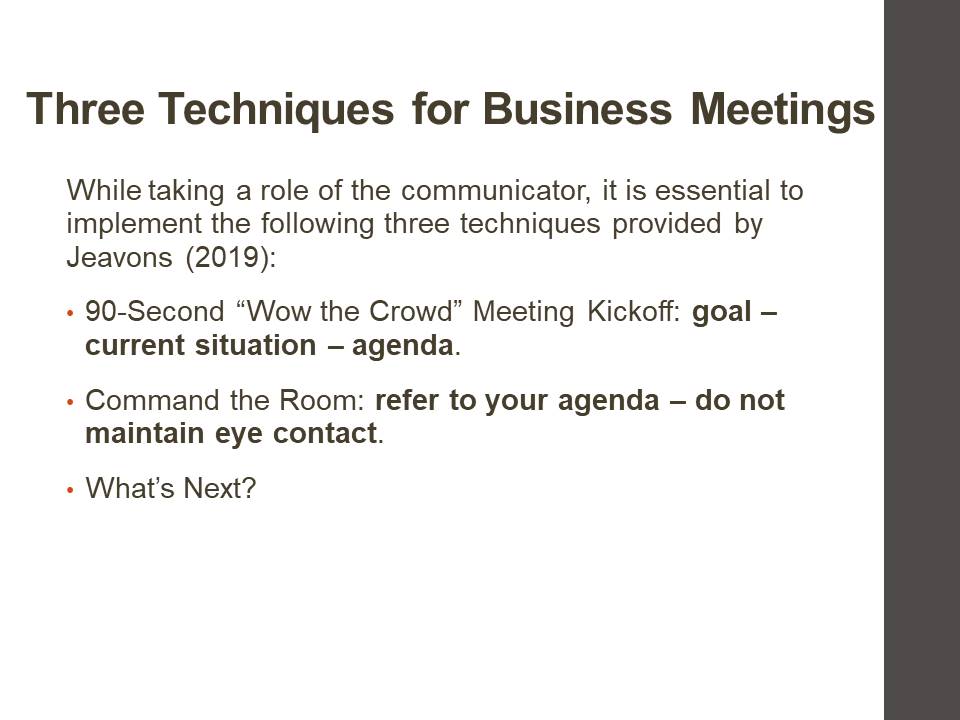
How to Start a Presentation
A powerful start is a key to the effective presentation that will draw attention of the audience. The essential starting points include:
- Focus on the message, not the delivery.
- Focused messages take time.
- Structuring the message with the Storyflow.
- Creation of the compelling content.
It is important to note that a successful presentation is not about the design of the slides, but about the impact one can make on the target audience. First, a speaker must be focused on developing, clarifying, and testing key messages, which is a time-consuming process. Therefore, the main goal is to make an impact on the audience that will continue after the presentation is completed and the speech is delivered with a powerful message. Furthermore, the Storyflow process is designed for a “carefully constructed and considered message” (Morton, 2014, p. 76). Altogether, these steps lead to creating a compelling content, which is a well-thought and structured mix of design, content, and message. With the aid of a proper content, the audience will be informed before the message drives forward.
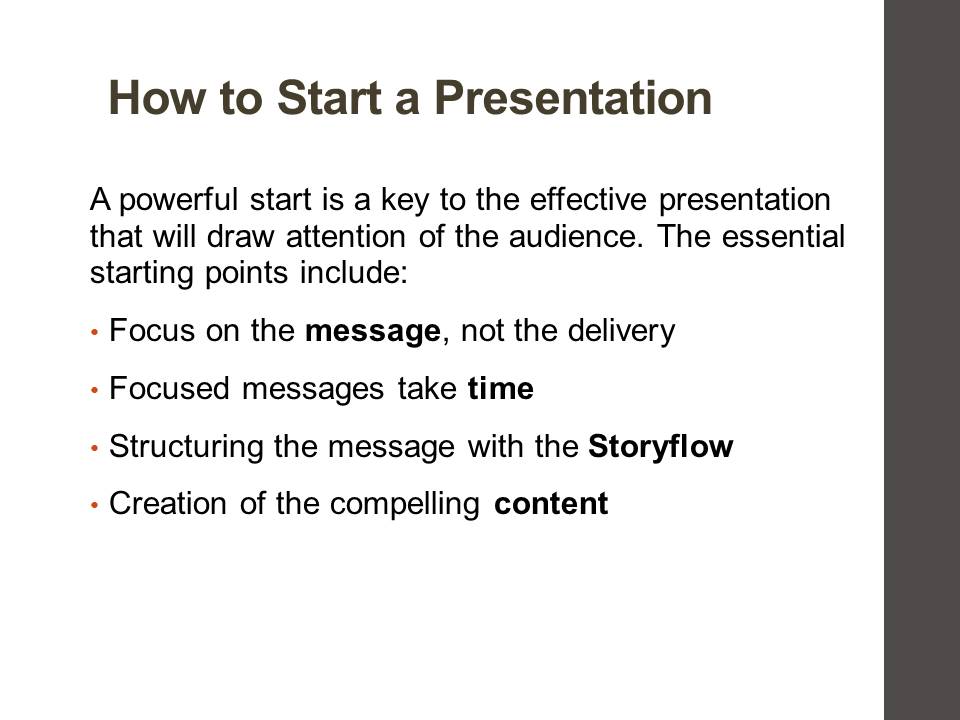
Storyflow Document Structure for a Powerful Message
- powerful message is the starting point of the more involved process (Fig. 2).
- focus on the message not the delivery.
- adhere to the storyflow strategy designed by Morton (2014, Fig. 3).

A well-constructed message must evolve into the core of a story. Hence, the storyflow development is a process developed to achieve this goal and is perceived as the chapter headings of the presentation story. It highlights the “structural elements, the high-level messages and the story’s logical flow” (Morton, 2014, p. 92). Furthermore, the storyflow structure aims at emphasizing the points one uses to move on to more detailed sections and provides rudimentary pointers within the script.
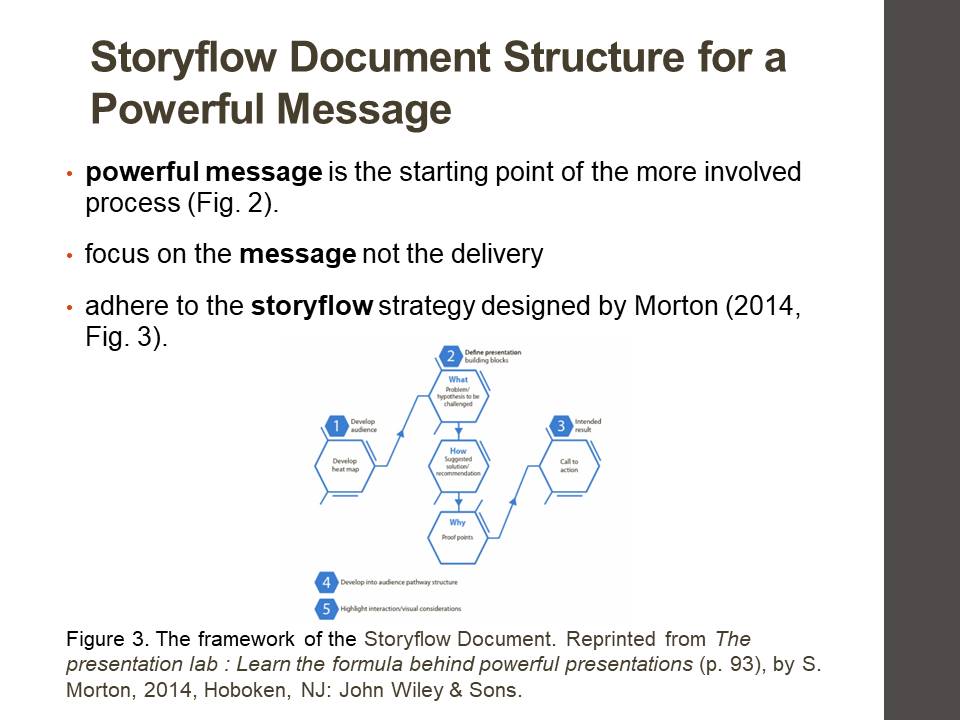
Business Audience Classification
The information in the presentation must be classified in accordance with the target audience and personality types.
Business groups can be categorized as:
- factual,
- visionary,
- emotional.
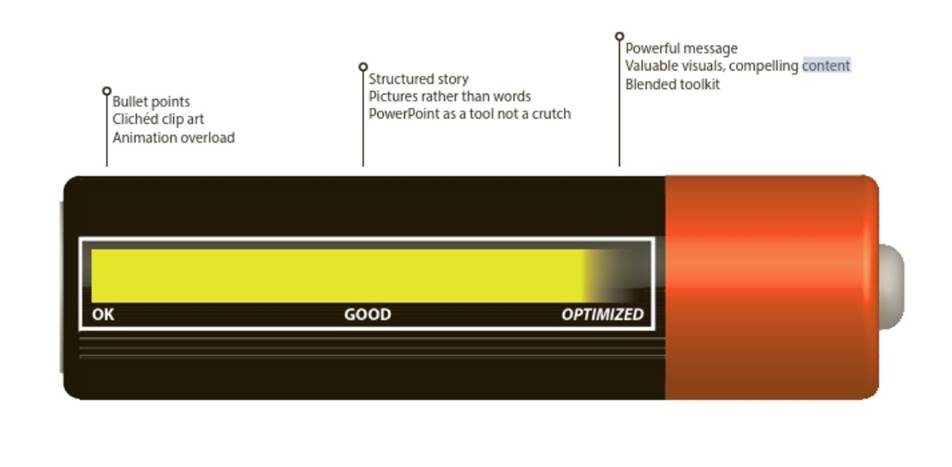
As for the factual group, data is of the utmost importance in the presentation; the factual audience makes decision that are based upon cold facts. The participants of the emotional group are driven by their heart and, therefore, pursue to feel good about the message or approach the speaker conveys. Morton states that such an audience implies a “sense of volatility”, which means they are quick to form opinions (p. 62). Hence, it is essential to establish the emotional bond with this kind of group. Ultimately, the visionary group appreciates the visual aids and perceives information accordingly. These are the people who “ponder, consider a broad range of factors, and apply them widely” (Morton, 2014, p. 62). Altogether, it is crucial to consider that most individuals tend to be the mix of all three aspects, however, in different quantities.
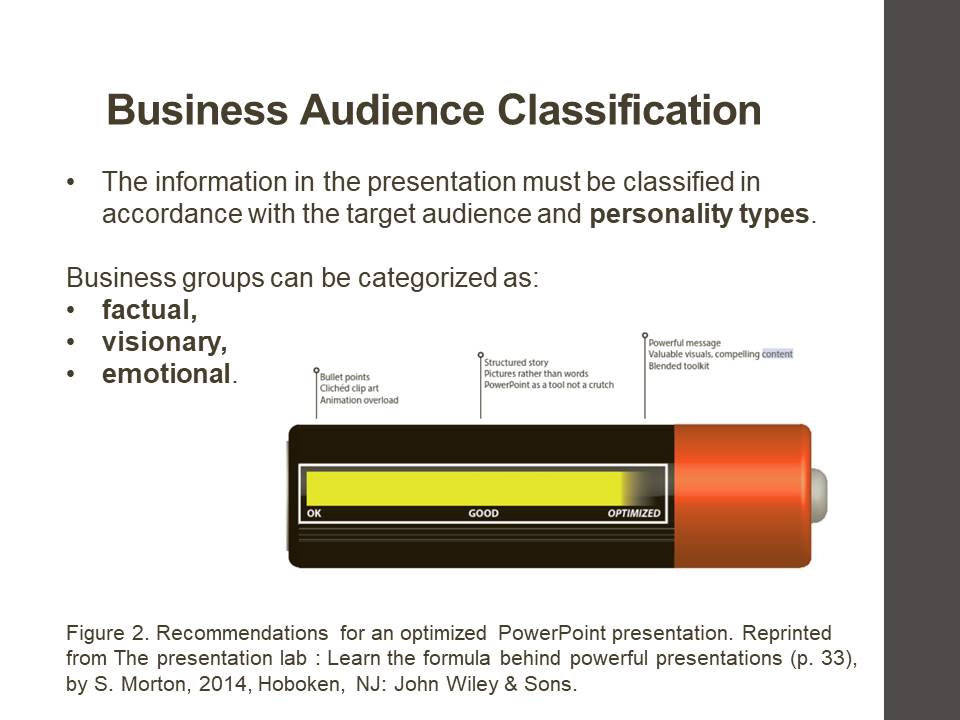
The Basics of the 10–20–30 Rule
- 10 slides per 1 presentation.
- 20 minutes as a time limit due to the technical malfunction.
- 30 points is the smallest font size as the way to force you to add less text and actually know your presentation and just put the core of the text on the slide. The bigger font is the key to the effective presentation.
- Black background.
Guy Kawasaki is an American marketing specialist and a Silicon Valley venture capitalist who developed his 10-20-30 rule of the PowerPoint presentation and presented it in The Art of the Start technology conference in 2006. Kawasaki (2006) compared the mistakes the entrepreneurs make in their presentations with a three symptoms disease that generally deny the principles of the unique proven team the speaker stands for. The basics of the 10-20-30 rule imply the following:
- 10 slides per 1 presentation is “what a mind can handle”;
- 20 minutes as a time limit, taking into account the technical malfunction with projector and a laptop;
- 30 points as the smallest font, which is the way to force a speaker to add less text and actually know the presentation. Such an approach aims at putting only the core of the information on the slide; Steve Jobs, for instance, used 96 point text. According to Kawasaki (2006), the bigger font is the key to more effective presentation.
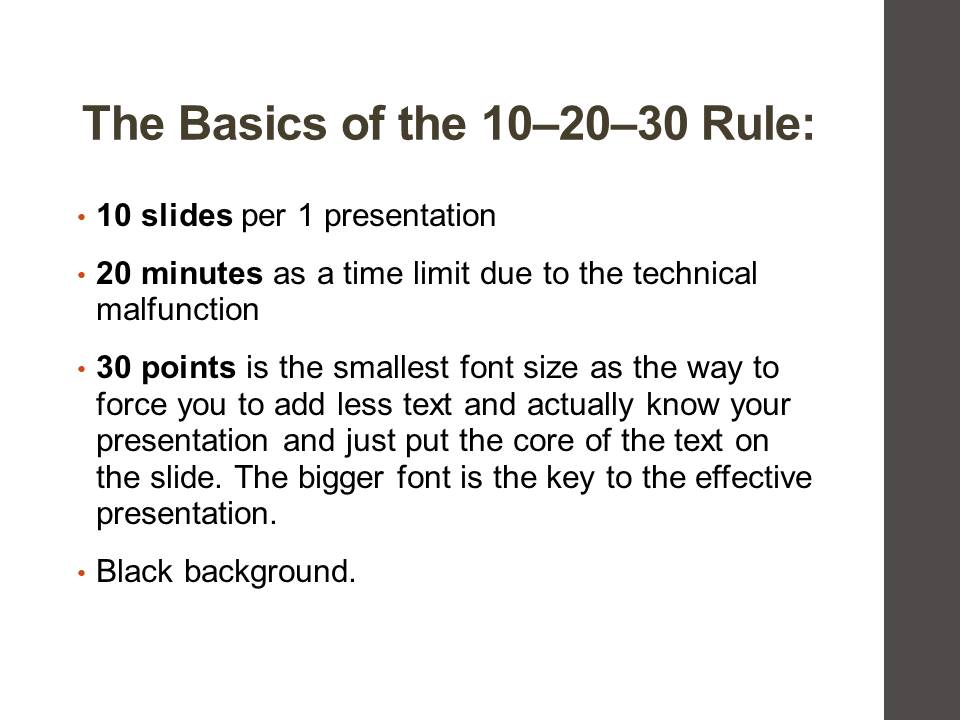
The “10–20–30 rule” by Guy Kawasaki
The ten topics that a venture capitalist cares about:
- Problem.
- Your solution.
- Business model.
- Underlying magic/technology.
- Marketing and sales.
- Competition.
- Team.
- Projections and milestones.
- Status and timeline.
- Summary and call to action.
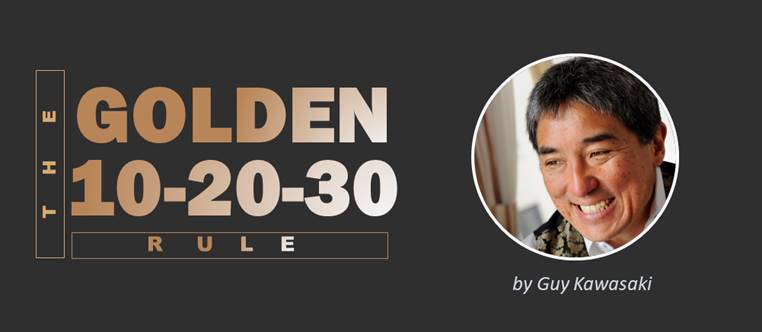
With that said, a small font reflects the speaker’s limited knowledge about presentation. Kawasaki (2006) also suggests the following algorithm: “find the oldest person in the audience and divide his or her age by two – this is the optimal font size”. In addition, a marketing specialist talked about the final yet essential feature of the successful presentation, which is the black background. He emphasized that a white text says seriousness, gravitas, caring, and quality, which is a common principle for the movie titles. However, it is a more complicated task to place the white text on the black ground than vice versa but it creates a much more attractive presentation. Furthermore, Kawasaki (2006) highlighted ten major topics a venture capitalist should include within 10 slides of the PowerPoint presentation.

Conclusion
- Presentation throughout a meeting might be a key to success of the entrepreneur.
- Creating effective presentations is an important skill to obtain.
- The analyzed strategies by Jeavons and Morton, as well as the alternative approach developed by Kawasaki, prove that it is vital to present information in a combined visual and oral format.
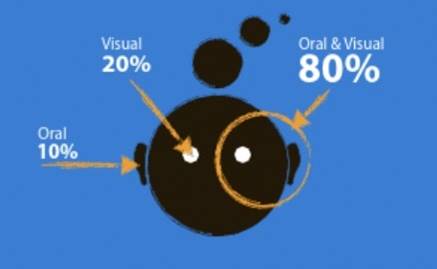
The analyzed steps and strategies are required for building a presentation story that is not only important for a speaker himself, but also delivers what the audience truly needs. The audience is the determining factor in the presentation process and, therefore, all the mentioned methods should be developed within its context and categories. Wharton School of Business concluded that 67% of audiences considered the presenters who combined both visual and verbal elements as more persuasive, “music to the ears of any sales presenter with a target to reach” (Morton, 2014, p. 126, Fig. 5). With that said, by studying the power of visual aids one might develop effective presentation skills that will contribute to the successful business career.
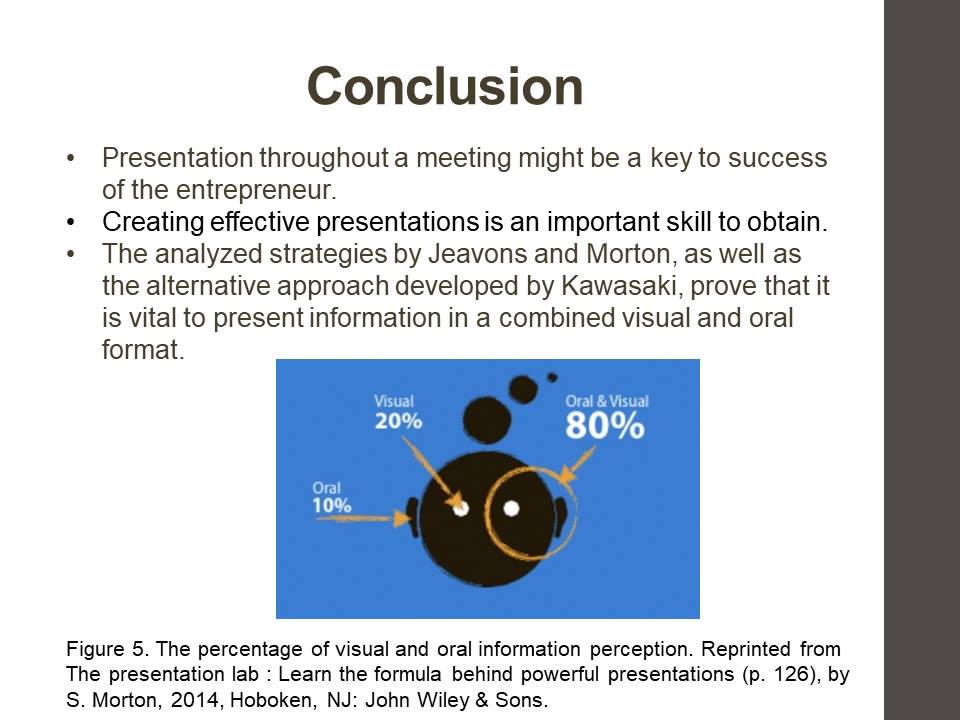
References
Jeavons, S. (2019). Effective presentation skills for business meetings. HMC Sales, Marketing And Alliances Excellence Essentials, 1-3.
Kawasaki, G. (2006). The art of the start at garage ventures & TiECon 2006 [Video file].
Morton, S. (2014). The presentation lab : Learn the formula behind powerful presentations. Hoboken, NJ: John Wiley & Sons.